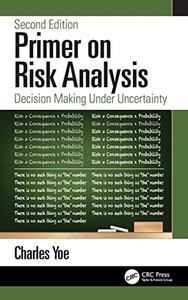
Sale
Risk And Decision Analysis In Projects
CreateSpace Independent Publishing Platform
ISBN13:
9781719014236
$39.95
$39.02
Decision analysis (DA) guides executives toward logical, consistent decisions under uncertainty. This book instructs readers in applying DA to feasibility analysis, project estimation, and project risk management.This is a wholly rewritten and expanded successor to the best-selling first and second editions.The entire investment lifecycle is covered, from conception, to the project plan, to the post-project review, and to a look-back analysis of the capital investment decision.DA applies to all manner of project management (PM) decisions for individuals, government, and non-profit organizations. The book uses a business investment perspective and assumes that maximizing value for the project owner is the objective.DA is a problem-solving process. There are four key features: 1) probabilities and probability distributions express best judgments about risks and uncertainties. 2) The organization has a decision policy expressed as a single metric (the objective function). 3) Probabilities and outcome values combine in the probability-weighting expected value calculation. 4) The organization as a policy to choose the best expected value alternative.This book aims to make decision making clear, simple, and logical. A clear decision policy can be elusive, and the author offers suggestions for making trade-offs among conflicting objectives. Converting the three pillars of project management (cost, schedule, and performance) into project value equivalents makes the trade-offs clear.This book is intended for serious PM students and practitioners. This is an essential concepts and how-to book. The scope is quantitative analysis, from project inception to post-project review. Project cost and schedule modeling, in modest detail, is essential to feasibility analysis and risk management. A general background in PM and corporate planning will be helpful. The methods are quantitative and straightforward. The reader should be comfortable with basic algebra and Microsoft(r) Excel(r).The book has eight pages of Suggested Reading annotated references (plus footnote additions), over 250 figures, approximately 600 Glossary definitions, and over 2400 Index entries. Online supplements include several whitepapers and other documents, example calculation spreadsheets, detailed color images of several important figures, four videos (including a critical chain simulation), and the Utility Elicitation Program (a web app, free for most users).Key topics include: Decision trees and Monte Carlo simulation for calculating outcome distributions and expected values * Probability concepts, including Bayes' rule for value of information analysis * Popular probability distribution types and when they apply * Eliciting expert judgments, with attention to potential cognitive and motivational biases * Recognizing the three pillars project in terms of project value * A 10-step decision analysis process * Project modeling concepts and techniques, with special attention to risk drivers and other correlations * Deterministic and stochastic sensitivity analysis * Decision policy that distinguishes objectives, time value, and risk attitude * @RISK(r) with Microsoft(r) Project for project simulations under uncertainty * Logical, consistent risk policy expressed as a utility function * Merge bias when task chains converge at a merge point * Tail estimate bias when estimating highly uncertain quantities * Optimizer's curse, a portfolio forecasting bias * Winner's curse, a bias characteristic of auctions * Using the best of critical chain and Monte Carlo simulation * Stochastic variance between a deterministic and a stochastic model * Modeling risk and uncertainty using probabilities, probability distributions, explicit formula relationships, correlation coefficients, risk drivers, conditional branching, and rework cycles.
- | Author: John R. Schuyler
- | Publisher: Createspace Independent Publishing Platform
- | Publication Date: Aug 21, 2018
- | Number of Pages: 518 pages
- | Language: English
- | Binding: Paperback
- | ISBN-10: 171901423X
- | ISBN-13: 9781719014236
- Author:
- John R. Schuyler
- Publisher:
- Createspace Independent Publishing Platform
- Publication Date:
- Aug 21, 2018
- Number of pages:
- 518 pages
- Language:
- English
- Binding:
- Paperback
- ISBN-10:
- 171901423X
- ISBN-13:
- 9781719014236





